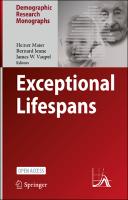Exceptional Lifespans
| dc.contributor.author | Maier, Heiner | |
| dc.contributor.author | Jeune, Bernard | |
| dc.contributor.author | Vaupel, James W. | |
| dc.contributor.editor | Maier, Heiner | |
| dc.contributor.editor | Jeune, Bernard | |
| dc.contributor.editor | Vaupel, James W. | |
| dc.date.accessioned | 2020-12-14T08:27:17Z | |
| dc.date.available | 2020-12-14T08:27:17Z | |
| dc.date.issued | 2021 | |
| dc.identifier | ONIX_20201214_9783030499709_15 | |
| dc.identifier | OCN: 1228844161 | |
| dc.identifier.uri | https://library.oapen.org/handle/20.500.12657/43277 | |
| dc.description.abstract | How long can humans live? This open access book documents, verifies and brings to life the advance of the frontier of human survival. It carefully validates data on supercentenarians, aged 110+, and semi-supercentenarians, aged 105-109, stored in the International Database on Longevity (IDL). The chapters in this book contribute substantial advances in rigorously checked facts about exceptional lifespans and in the application of state-of-the-art analytical strategies to understand trends and patterns in these rare lifespans. The book includes detailed accounts of extreme long-livers and how their long lifespans were documented, as well as reports on the causes of death at the oldest ages. Its key finding, based on the analysis of 1,219 validated supercentenarians, is that the annual probability of death is constant at 50% after age 110. In contrast to previous assertions about a ceiling on the human lifespan, evidence presented in this book suggests that lifespan records in specific countries and globally will be broken again and again as more people survive to become supercentenarians. | |
| dc.language | English | |
| dc.relation.ispartofseries | Demographic Research Monographs | |
| dc.subject.classification | thema EDItEUR::J Society and Social Sciences::JH Sociology and anthropology::JHB Sociology::JHBD Population and demography | en_US |
| dc.subject.classification | thema EDItEUR::J Society and Social Sciences::JB Society and culture: general::JBS Social groups, communities and identities::JBSP Age groups and generations::JBSP4 Age groups: the elderly | en_US |
| dc.subject.classification | thema EDItEUR::M Medicine and Nursing::MJ Clinical and internal medicine | en_US |
| dc.subject.other | Demography | |
| dc.subject.other | Aging | |
| dc.subject.other | Internal Medicine | |
| dc.subject.other | Aging Population | |
| dc.subject.other | Ageing | |
| dc.subject.other | Population and Demography | |
| dc.subject.other | Supercentenarians | |
| dc.subject.other | Longevity | |
| dc.subject.other | Oldest-old | |
| dc.subject.other | Mortality | |
| dc.subject.other | Age validation | |
| dc.subject.other | open access | |
| dc.subject.other | Max Planck Institute for Demographic Research | |
| dc.subject.other | International Database on Longevity IDL | |
| dc.subject.other | Population & demography | |
| dc.subject.other | Age groups: the elderly | |
| dc.subject.other | Age groups: adults | |
| dc.subject.other | Clinical & internal medicine | |
| dc.title | Exceptional Lifespans | |
| dc.type | book | |
| oapen.identifier.doi | 10.1007/978-3-030-49970-9 | |
| oapen.relation.isPublishedBy | 6c6992af-b843-4f46-859c-f6e9998e40d5 | |
| oapen.imprint | Springer International Publishing | |
| oapen.pages | 344 |

